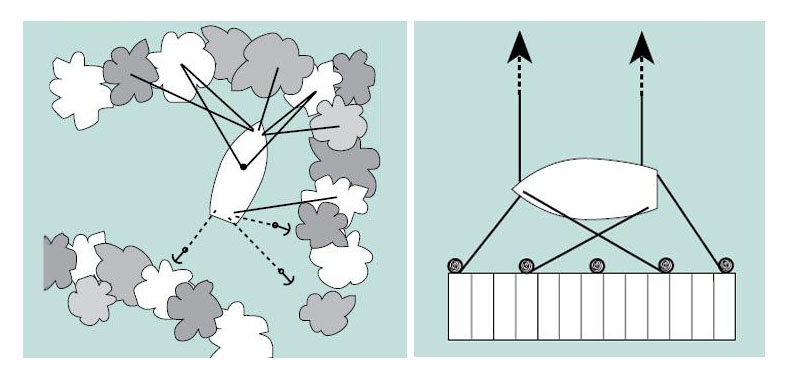Recently, NOAA issued an updated hurricane forecast, indicating a windy road ahead. After thinking about protecting yourself and your family, what about the boat? Tis the season of heavy weather. This column is about that.
Let Me Say It Again…
Never stay on the boat. I know. There are old timers that swear by it. “I’ve saved my boat every time when others were lost.” With absolute certainty, it is simply because the winds – and seas – never exceeded the operational capacity of the engines. But when they do, you will be lost with the boat. The boat is just money. You are someone. If you care about the people who care about you, read on – and leave the boat behind while you take your loved ones to high ground.
The Spider Web of Lines
If you can’t get the boat out of the water and on to “the hard”, then you are compelled to protect her in her natural element – the water. But the sea presents forces magnified beyond the speed of the wind – it is the momentum of the wind-driven seas and the tidal surge. The storm tide is added to the astronomical tides. And when those waves hit something solid, they generate force dozens of times more powerful than wind of the same speed. Sandy generated a storm surge of 14 feet. Andrew generated a storm tide of 17 feet. Camille in 1969? 24 feet. Dorian made the Bahamas look like Hiroshima…
While nothing will save the boat from that, the vast majority of storm-driven tidal surges are significant but really fractions of that. So, with a “spider web of lines”, you can create a fighting chance that your beauty will ride out the storm.What is common to all these configurations is lots of lines and long expanses of them. In two of them, you can also see that multiple anchors are used as well. The longer lines are there to address the tidal surge. The additional lines are there for back-up. Losing one line to stress doesn’t completely undo everything you’ve done.

Chafe Guards
Without doubt, you will need chafe guards of some kind since the storm will put extreme stresses on the lines where they are wrapped around the cleats and chocks. Your ground tackle too will need additional chafe protection. Think of the storm as putting a summer’s worth of stress on your lines – for every hour of ‘blow.’ If you go through a set of lines every two summers, they will never withstand a half-day of a serious ‘blow.’ And that is assuming that they are new.
What to use? The universal winner-take-all is old garden hose. Lay the line through a length of hose and lay that through the chock or along the toe rail where your line crosses the gunwale on its way to a cleat on the dock. In a pinch, duct tape (a TON of it) works really well. And it is more pliable than garden hose. For the aficionados, they will hate it because it looks like hell – but it works. BTW, while you can (now!), be sure that the cleats on the boat and on the dock are through-bolted with a backing plate. If not, they will become high-speed guided missiles as they fly out of their bedding under strain. And the boat will be free… No garden hose? Improvise. Leather straps. Rags. Anything helps, just some things help more than others.
Cut Your Windage
Do whatever you can to lower the boat’s profile to the wind. Take down the bimini cover and lash it. If you can’t, open the windows. Take down the antennas. Even that little bit of additional windage can tip the balance. A sailboat? I know I don’t need to say that you must stow all the sails, even the furled ones, below or ashore. If the boat has dorades or cowls, seal them. Wind – or wind-driven water – getting below at high speed can’t be good. Duct tape… And take in all the electronics and seal the boat’s electrical leads with tape.
Fenders and Fender Boards
Yes. As many as possible, put them out. I always suggest that they be secured to the boat, rather than the dock. If the boat does break free, at least she is taking some of her protection with her.
In Summary
Make a check list – now. If you need one, email me below and I will send you one. Do you want a copy of the BoatUS guide for boat and marina owners? Email me below and I’ll send that too. And remember these words:
“The time for taking all measures for a ship’s safety is while still able to do so. Nothing is more dangerous than for a seaman to be grudging in taking precautions lest they turn out to have been unnecessary. Safety at sea fora thousand years has depended on exactly the opposite philosophy.”
- Admiral Chester W. Nimitz
BTW, if you are interested in being part of USCG Forces, email me at JoinUSCGAux@aol.com or go direct to the D1SR Human Resources department, who are in charge of new members matters, at DSO-HR and we will help you “get in this thing…
